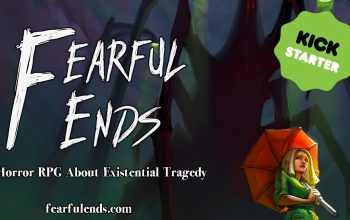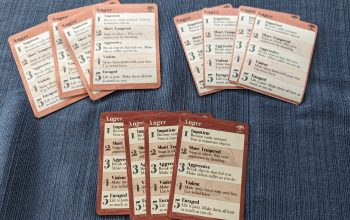
Last night I ran the first playtest of Checkpoint Zulu. As is typical for the Cthulhu games I write, the first playtest was a hot mess. I made a ton of classic mistakes, but I never seem to see these until I’ve run a playtest. Despite this I think I was still able to keep it fun for the players, and of course I learned a ton. Here’s a quick rundown of take-aways:
What Went Right
Great setting – I think I hit the espionage notes the best not by intrigue within the group, but by putting them into backgrounds that are just classic spy tropes. A dead drop at a casino. A foot chase and gun fight through a zoo in the middle of the night. These scenes came and went quickly, but man did it make the game feel like a spy game.
The big bad – The slow reveal and eventual horror of the big bad at the end was great. I think I need to re-work it a little bit to give myself more time to play with it, and more opportunities for the players to experience and react to it.
Props – Some props were just fantastic. Everyone seemed to love the phone. You can put anything in a little plastic bag and it looks like drugs – I chose Spree candies and the players loved it, especially when I tied in-game effects to taking the drugs. Also, everyone likes to wear a silly hat.
What Went Wrong
Time – Of course I’m always super worried about pacing, but this test game ran into some extra complications. Due to illness and weather I had two players cancel. That’s fine, I can run with just 4, but I put out a call around the office to see if others wanted to jump in last minute. I had two interested players, but each had other obligations which meant they would have to leave early. While this is fine for a normal RPG, it’s rough for a playtest of a convention game when I’m trying to figure out pacing. We shifted the game an hour earlier so they could play longer, but this meant an awkward break in the middle for food. All in all, I’m not sure I got a good sense of how this game fits into 4 hours. I’ll definitely need a second playtest.
Way too much content – I get so sucked into the research I end up wanting to cram every single detail I discover into the game. The fact is, four hours of casual roleplay can hardly contain weeks of intense research. Yet for some reason when I’m on my own just writing I’m always sure I haven’t prepared enough. Less is more.
Player distrust – Given the espionage theme, I made characters that come from very different backgrounds and while they are generally on the same side, they have their own agendas and secrets. Unfortunately while I expected at least surface cooperation this wasn’t totally clear to the players, who weren’t sure which other players they should trust, and it took a long time for them to gel as a team. I think I may edit the characters to be more formally tied together (members of the same government agency or similar). They can still have secrets, but I think it will be good to just start out with an obvious connection so they’re encouraged to work together early.
Opening scene – I used my method from the Mazes and Monsters game of having an opening scene where all the players collide and try to pursue differing agendas. While this did create glorious chaos at the start, I think it actually worked against getting the players into the plot. They had fun bouncing off each other, but ultimately that just extended the distrust and delayed them figuring out what exactly they were supposed to be doing. As much as I like this technique, it may simply not be right for this particular game.
Plot advancing clues – It seems to be a universal truth that the clues you give players that you think are painfully obvious will soar right over their heads, and the info you thought you hid behind a complex mesh of indirection they’ll discover immediately. Unfortunately I’ve realized that the stuff that really kicks the plot of this game off requires some deduction of information distributed to two of the characters. If those two players don’t work well together, the game could stall out. I think the answer to this is going to be simply changing one of those characters into an NPC so I can use them to help push the plot along.
Not enough insanity – There was so much investigation in this game that the insanity cards only came out very late. I don’t think I saw players really suffering until the game was almost over, and that didn’t leave much time for them to roleplay the effects. Of course, more insanity would only make it harder for them to complete the investigation part, which probably means I need to trim more of the investigation and let them revel in going mad or getting themselves killed.
The wall – Oh man did the players want to find a way to cross the wall. They spent a lot of time coming up with terrible ideas of how to cross it and smuggle people back. I don’t think I did a good job in the basic background of the game showing them just how difficult and dangerous this really was, or making it clear that there was a better/easier way to reach their objective.
Too many props – While the map of Berlin looks awesome, I think it was more valuable to me for finding locations for scenes than for use by the players. I also worry it lead to them thinking they were supposed to use it to plan their wall crossing. I should probably just ditch it. Also, I’m used to having player hand outs with clues embedded in them having extra weight due to their physicality. In this case there were so many props that did not happen, and perhaps that made some clues harder to spot.
Conclusion
It’s funny, but I think it’s basically impossible for me to write a compelling horror game without workshopping it with patient players first. Now that I’ve seen what did and did not work I’m sure I can go back and re-write the game to ditch the extraneous stuff and focus on the important bits. Giving the players a common background to enforce immediate trust and changing that one character to an NPC I think is really going to make the opening speed along.
I’d also like to figure out how to push the players into doing more planned operations where they have to position themselves at a location prior to an event. Perhaps a simple map of a few locations, like the Casino, will help with this. I think this will both help the espionage feel, and hopefully also push the players into being a little more physically separated so I can maybe reveal some horrors to a couple of them earlier and get the insanity train rolling sooner.
Man, I have a lot of re-writing to do. I can’t wait.


